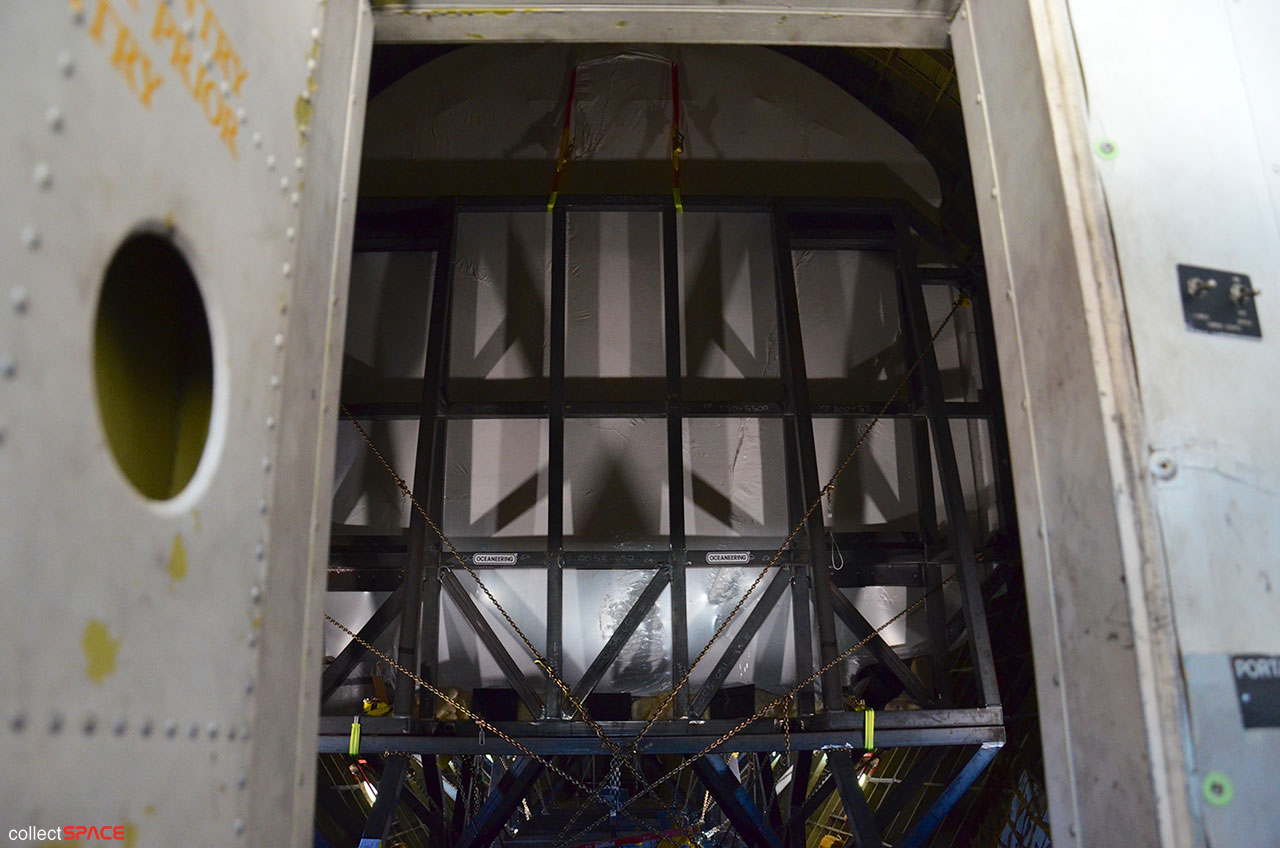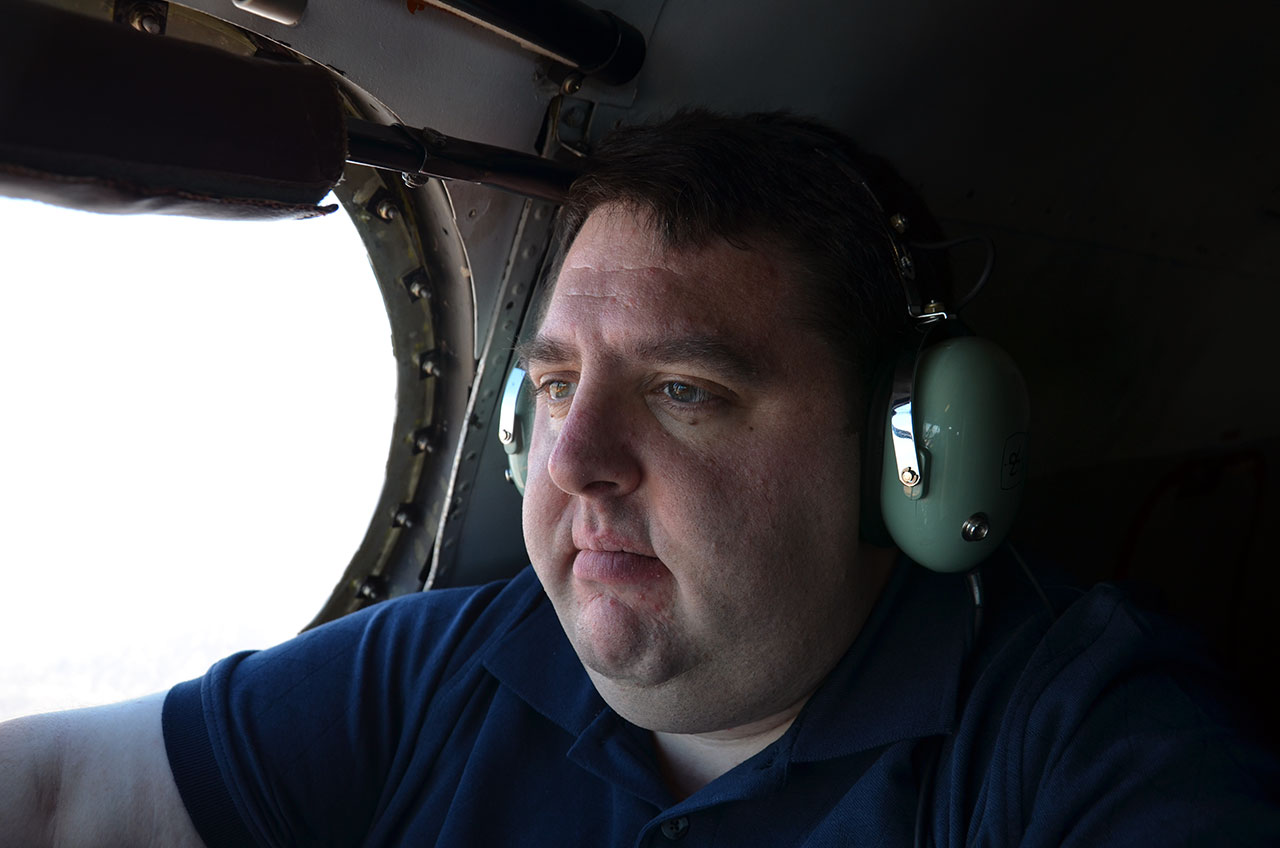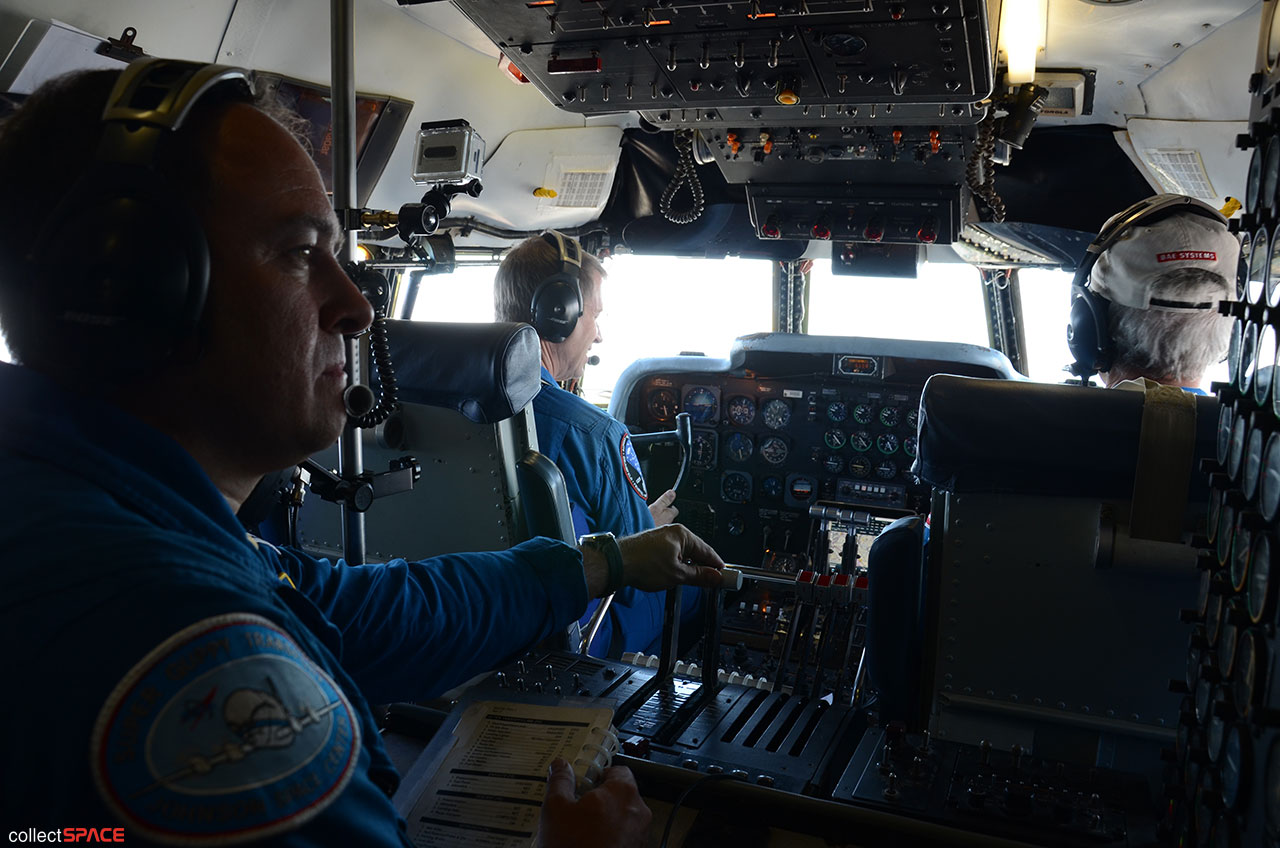NASA’s Flying Fish: Riding Aboard the Super Guppy Aircraft

This story was updated on July 1 at 9 a.m. ET
TRAVIS AIR FORCE BASE, Calif. — On Saturday (June 30), visitors to The Museum of Flight in Seattle will get an up-close look at a very unusual NASA aircraft. In fact, it’s not uncommon for air traffic controllers and even fellow pilots who spot the "Super Guppy" to ask a simple but telling question: “What are you?”
I got to find out first-hand. On Thursday, I was invited by NASA to not just tour but fly aboard the Super Guppy, a bulbous cargo plane, as it flew between air bases near Los Angeles and San Francisco. The 90-minute trip up the California coast is one I won’t soon forget, and according to the Super Guppy’s flight crew, it was a rarity — perhaps even a first — for a civilian reporter.
I caught up with the Super Guppy — which is the last in a small fleet of Guppy aircraft flying after 50 years — at March Air Reserve Base in southern California. It’s there that I met the team I’d be flying with, including flight engineers Michael Robinson and David Elliot, aircraft mechanics and loadmasters Dan Thompson, Bob Coyne and Jon Myrick, and pilots Dick Clark and Greg C. “Ray-J” Johnson.
If one of those names sounds familiar, it should. Johnson is a NASA astronaut and one of the stars of the IMAX movie “Hubble 3D.” Before piloting the Super Guppy, he piloted space shuttle Atlantis on the fifth and final mission to upgrade the Hubble Space Telescope.
Before I boarded the Guppy, I had the chance to see it take off and land. Its “swollen” appearance — it looks like a cartoon anthropomorphic plane that held in a massive sneeze — is as deceptive as it is daunting. [Gallery: Soaring with Seattle's Space Shuttle Trainer]
The Guppy looks like it shouldn’t be able to fly, especially when you consider that its cargo hold, which measures 111 feet long by 25 feet wide by 25 feet high (34 by 8 by 8 meters) can carry payloads weighing upwards of 26 tons.
Breaking space news, the latest updates on rocket launches, skywatching events and more!
So when it came to take my seat, I’ll admit there was just a slight hesitation. Not that I doubted my flight crew’s skills or even the safety record of the Super Guppy, but just what it would feel like in-flight.
It didn’t help all that much seeing our payload for this leg of the Guppy’s three-day trip to Seattle sitting in the cargo hold. Inside the plane was a space shuttle. To be clear, it was just the 16,000-pound (7,300 kilograms), 28-foot (8.5 m) nose section of a shuttle mockup. Part of the Full Fuselage Trainer (FFT), the crew compartment was used to train every person who flew on the real shuttles over the span of three decades.
Now it was the FFT’s turn to fly — and mine.
Welcome aboard
I was shown to my chair, a two-seat couch in the rear of the Guppy’s cockpit. These seats, and the seats to my left, are where the aircraft’s mechanics sit. In front of me was the flight engineer’s station and in front of that, the pilots’ seats. What really caught my eye, though, was what was in front of them: windows, and a lot of them.
From outside, the sheer size and dimensions of the Super Guppy grab your attention. But inside, the panoramic, 180-degree view out the forward floor-length windows are the star attraction. The only way to get a better view of the ground would be to swing open the nose of the Guppy, which can rotate 105 degrees to load its large payloads.
From my seat at the rear of the cockpit, I had to crane my neck to see just a sliver of the action. But any thought of unbuckling my seat belt and standing up to get a better view was erased when the crew powered up the Guppy’s four turboprop engines for takeoff.
"We’re going to use most of the runway," Johnson said to his crewmates. The sudden burst of speed — we had been taxiing for a few minutes — pushed me back into my seat. It was a lot bumpier than a commercial airline, too. But the transition from ground to air was smooth, almost unnoticeable, and the climb to altitude was a lot slower than the commercial flight that brought me to California.
The gradual climb was a good thing, too. It gave Myrick, outfitted with knee pads and gloves, time to jump into the cargo hold to climb over and around the shuttle trainer to make sure it was still chained down and where it was supposed to be. [Images: NASA's Visions for Future Airplanes]
Once he finished, Thompson and Coyne went down into the lower cargo hold to shut the lower door that separates the unpressurized back of the plane from the pressurized cockpit.
We climbed to 14,000 feet (4,267 m), the Guppy’s cruising altitude, and were told by the tower to head out over the water for Santa Catalina Island and then head toward Los Angeles.
"There’s the Pacific Ocean, boys," said someone toward the front of the cockpit. "Ten bucks for anyone who sees a whale."
Window seat
The only cetacean in sight, however, was the flying variety. The aircraft may be called the Guppy, but it’s much more akin to a whale: large, slow-moving and possessing a voracious appetite — for fuel.
The most frequent callout among the crewmembers was a check of the remaining fuel, for the huge Guppy burns through its reserves at a rapid pace. As such, flying west and then north was not the most efficient use of the Guppy’s gas.
Clark called the tower and requested to go to VFR — visual flight rules — rather than follow the out-and-about flight plan the tower had chosen. We gradually banked right and began following the coast north.
It was about this time that my view got a whole lot better. Myrick had set a small garbage pail behind Clark and offered me a seat. From here, I had a bank of windows to my right and Clark to my left. I could view both the cockpit controls and the spectacular landscapes we were passing.
Sightseeing turns out to be a good way to pass the time. Both Clark and Johnson took turns pointing out airfields, city spots and natural landmarks. This wasn’t for my benefit; it was for them. I was just happy to take advantage of their geographical skills (and the GPS running on an Apple iPad positioned between them).
We flew over John Wayne Airport in Orange County, NASA's Jet Propulsion Laboratory in Pasadena and the nearby Rose Bowl stadium. In the distance we could see Mount Whitney, at 14,505 feet (4,421 m) the tallest peak in the continental United States. And depending on who you talk to on the crew, we may have seen Yosemite National Park, too.
But the most memorable sight, at least to me, was the dry lakebed at Edwards Air Force Base. Clearly visible was Runway 22, the same landing strip where Johnson landed on space shuttle Atlantis in 2009. (After the flight, I asked Johnson about the differences between flying the shuttle and the Guppy. He told me the shuttle flies a lot faster but the Guppy flies a lot heavier.) [10 Military Aircraft That Never Made it Past Test Phase]
Thank you for flying
When we weren’t looking out the window, the crew focused on their flying — and their snacks. There were “Guppy Gummies” — I didn’t get a good look at them so I don’t know if they were fish-shaped or not — and beef jerky, Johnson’s favorite (he brought jerky with him to space).
I didn’t get the sense they were censoring their behavior because I was there, or because two GoPro cameras were documenting the trip for The Museum of Flight. Rather, they were a professional crew who respected the Super Guppy and were proud of their service to NASA.
The landing at Travis Air Force Base was much smoother than I expected. Make no mistake, it was still bumpy, but despite the crosswinds, the touchdown was far from jarring. You could almost forget that there was a space shuttle nose in the very large trunk. Almost.
Back on the ground, it was time for me to part ways with the Guppy. I’ll be in Seattle on Saturday, however, to see the cargo plane — and its crew — arrive to well-deserved fanfare. They may have been delivering a piece of space shuttle history, but their ride should enjoy a little time in the spotlight, too.
See collectSPACE.com for more photos and continuing coverage of the Super Guppy’s flight to Seattle.
Editor's Note: This story was corrected to properly identify that NASA's Super Guppy aircraft's nose opens to a105-degree angle, not 200-degree, and to properly identify statements and actions by loadmasters Jon Myrick and Dan Thompson.
Robert Z. Pearlman is the editor of collectSPACE.com, the leading online space history publication and a SPACE.com partner. You can follow @robertpearlman on Twitter or on Facebook. Follow SPACE.com on Twitter @Spacedotcom and on Facebook.

Robert Pearlman is a space historian, journalist and the founder and editor of collectSPACE.com, a daily news publication and community devoted to space history with a particular focus on how and where space exploration intersects with pop culture. Pearlman is also a contributing writer for Space.com and co-author of "Space Stations: The Art, Science, and Reality of Working in Space” published by Smithsonian Books in 2018.
In 2009, he was inducted into the U.S. Space Camp Hall of Fame in Huntsville, Alabama. In 2021, he was honored by the American Astronautical Society with the Ordway Award for Sustained Excellence in Spaceflight History. In 2023, the National Space Club Florida Committee recognized Pearlman with the Kolcum News and Communications Award for excellence in telling the space story along the Space Coast and throughout the world.



